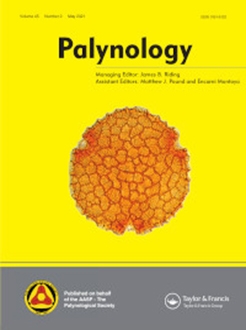This study focuses on five cores in and around three of the hundreds of shallow ephemeral hypersaline lakes distributed in chains along traces of ancient drainages that dominate the southern Western Australian landscape. Cores within and on the shore of Lake Aerodrome (LA1-09, LA2-09), Prado Lake (PL1-09, PL2-09), and Gastropod Lake (GLE1-09) in the Cowan Paleodrainage were drilled as part of a multidisciplinary study to understand the evolution of the lakes. Lithological and palynomorph data provide insights into the region's the depositional history, and floristic and climate evolution of the region. The nearly 60 m deep LA2-09 core provides the most comprehensive data. The basal ∼15 m interval of this core comprises two distinct lignite units with a clay interbed that preserve a rich palynomorph assemblage of the Werillup Formation. This assemblage is characterized by the first appearance datum (FAD) and last appearance datum (LAD) of key late Eocene taxa that correlate with the Middle Nothofagidies asperus Zone, and is indicative of freshwater swamp surrounded by subtropical to temperate rainforest. Above the upper lignite (except the topmost sample), evaporitic-siliciclastic units preserve a depauperate palynomorph assemblage comprising mostly long-ranging sclerophyllicxerophilous-halophilic taxa. The pollen Myrtaceidites lipsis constrains the age of the upper ∼23 m interval as Pliocene to Recent. This younger assemblage also preserves reworked palynomorphs from the Werillup Formation and older units, and is identified in the other four cores. The presence of the halophilic green alga Dunaliella in the younger assemblage is used as a proxy for aridity and hypersaline conditions during post-Eocene deposition in southern Western Australia. Its absence in the neutral-alkaline lake water and uppermost core samples of GLE1-09 is either due to predation by the acidophobic gastropod Coxiella residing in the lake, or the fact that the type of Dunaliella preserved in the core samples is acidophilic.
How to translate text using browser tools
3 May 2021
Palynomorphs in Southern Western Australian Lake Sediments: Evidence of Climate Change and Hypersalinity During the Cenozoic
Carlos A. Sanchez Botero,
Francisca E. Oboh-Ikuenobe,
Lutfia Grabel,
Onema C. Adojoh
ACCESS THE FULL ARTICLE
It is not available for individual sale.
This article is only available to subscribers.
It is not available for individual sale.
It is not available for individual sale.

Palynology
Vol. 45 • No. 2
May 2021
Vol. 45 • No. 2
May 2021
acidic-saline lakes
Dunaliella
evaporite
Late Eocene
Pliocene
Werillup Formation
Western Australia





